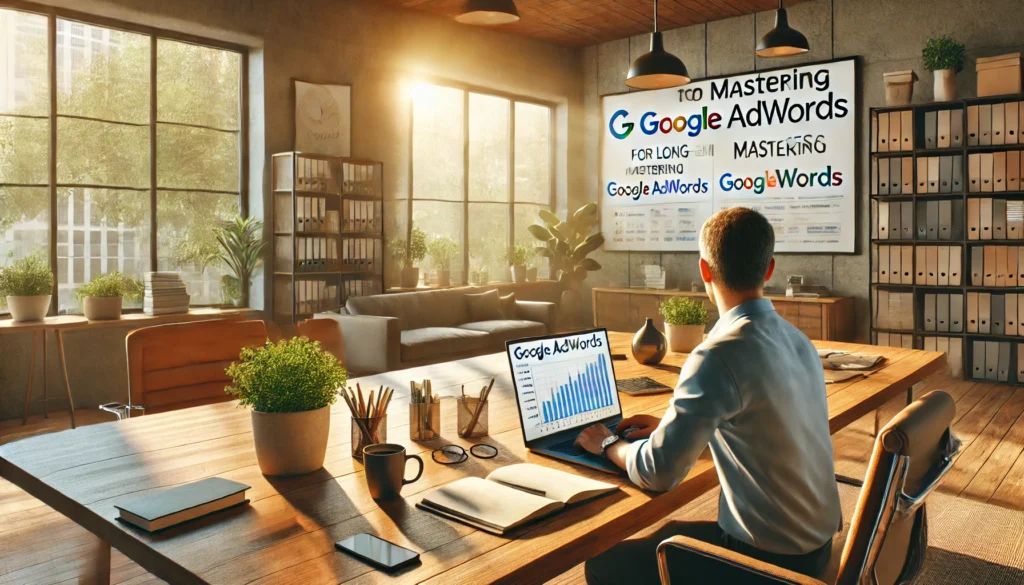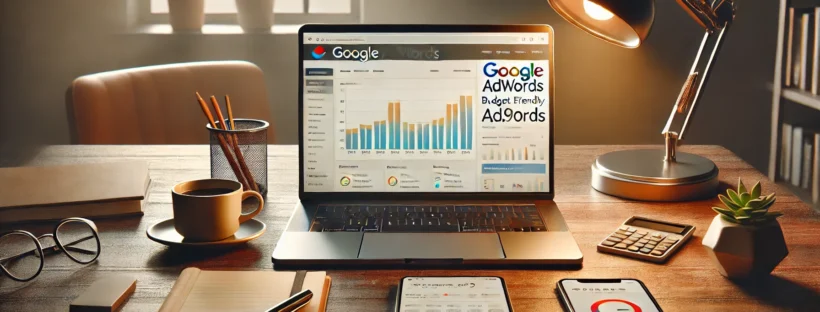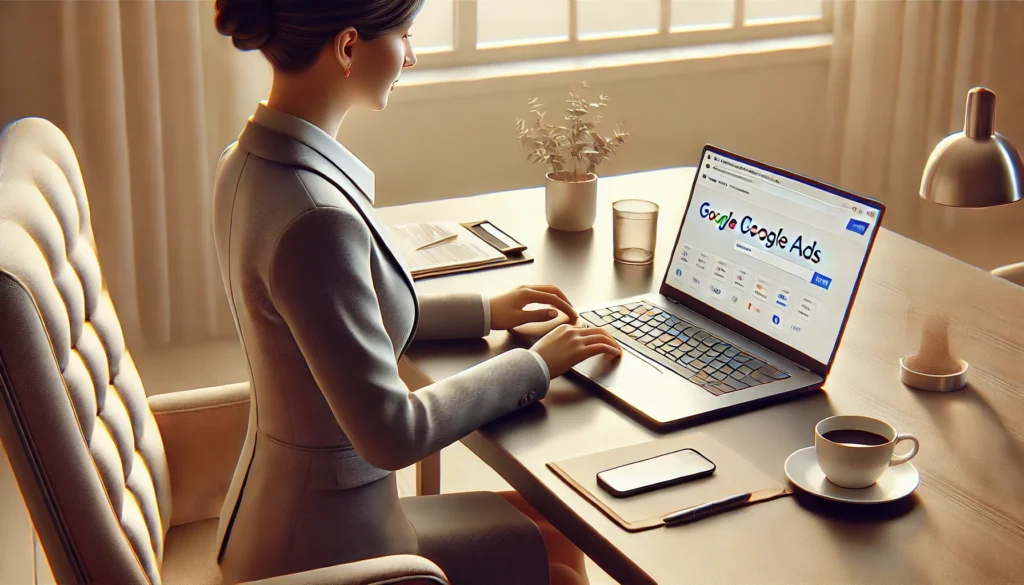Imagine pouring time and effort into building your business, only to see your website lost in the vastness of the internet. You know your products or services are valuable, but how do you get them in front of the right audience? This is where Google AdWords becomes a game-changer.
In today’s fast-paced digital marketing landscape, businesses need more than just a website; they need visibility, engagement, and, ultimately, conversions. Google AdWords, now known as Google Ads, is one of the most powerful digital marketing channels, allowing businesses to place targeted ads at the top of search engines, reaching potential customers exactly when they are searching for relevant products or services.
This guide will break down the essentials of Google AdWords, from setting up high-performing campaigns to advanced bidding strategies. Whether you’re a beginner or looking to refine your digital marketing strategy, this article will help you navigate the challenges and maximise your return on investment.
Understanding Google AdWords and Why It Matters
Google AdWords is at the heart of search engine marketing, offering businesses a direct way to reach their target audience through paid advertisements. Unlike traditional marketing, where businesses rely on broad exposure, Google AdWords ensures that ads appear when users actively search for specific products or services.

Key Benefits of Google AdWords
- Increased Visibility – Ads appear at the top of search engines, ensuring immediate exposure.
- Targeted Traffic – Businesses can tailor ads based on keywords, demographics, and user intent.
- Measurable ROI – Unlike traditional marketing channels, every click, impression, and conversion is trackable.
Google Ads vs. Other Digital Advertising Platforms
While social media marketing platforms like Facebook and Instagram focus on engagement, Google AdWords capitalises on intent-driven searches. Users on Google are actively looking for solutions, making it a highly effective platform for businesses aiming to drive immediate conversions.
This deep level of control over audience targeting and budget allocation makes Google AdWords a fundamental part of any successful marketing strategy.
Setting Up a High-Performing Google AdWords Campaign
A successful Google AdWords campaign requires a strategic approach, from selecting the right campaign type to crafting compelling ad copy and optimising landing pages. Here’s how to get started:
Choosing the Right Campaign Type
Google Ads offers several campaign types, each suited to different business goals:
- Search Ads – Appear at the top of Google search results, ideal for capturing high-intent searches.
- Display Ads – Visual banners across websites and apps, great for brand awareness.
- Shopping Ads – Showcase products with images and prices, perfect for eCommerce businesses.
- Video Ads – Displayed on YouTube, effective for video marketing strategies.
- Performance Max – Uses automation to serve ads across multiple digital channels for maximum reach.
For a detailed breakdown of campaign types, refer to Google’s official Ads guide.
Keyword Research & Selection
Choosing the right keywords ensures your ads appear for the most relevant searches. Consider:
- Keyword Intent – Target transactional keywords to attract users ready to convert.
- Research Tools – Use Google Keyword Planner, SEMrush, or Ahrefs for data-driven keyword selection.
- Negative Keywords – Filter out irrelevant searches to avoid wasted ad spend.
A comprehensive keyword strategy is essential for effective search engine marketing.
Ad Copywriting Best Practices
Your ad copy must capture attention and drive clicks. Follow these principles:
- Compelling Headlines – Use clear, action-oriented language.
- Persuasive CTAs – Encourage users to take action (e.g., “Get a Free Quote Today”).
- Relevance – Align ad copy with search intent and landing pages.
Landing Page Optimisation
A high-performing marketing strategy ensures ads lead to optimised landing pages. Best practices include:
- Consistency – Match the ad message with the landing page content.
- Strong UX – Use fast-loading, mobile-friendly designs.
- A/B Testing – Experiment with layouts, CTAs, and headlines to maximise conversions.
By carefully setting up your Google AdWords campaign, you can drive high-quality traffic and increase conversions while maintaining cost efficiency.
Budget Management & Bidding Strategies
Effective budget management and bidding strategies are crucial for maximising ROI in Google AdWords. Without the right approach, businesses can either overspend or miss valuable opportunities. Here’s how to allocate your budget wisely and bid strategically.
Understanding Bidding Options
Google Ads offers several bidding strategies tailored to different goals:
- Manual CPC (Cost-Per-Click) – Gives full control over bid amounts but requires close monitoring.
- Enhanced CPC – Adjusts manual bids based on conversion likelihood.
- Automated Bidding – Google’s AI optimises bids based on user behaviour and conversion probability.
Each strategy serves a different purpose—Manual CPC suits those who want control, while Smart Bidding (automated options) helps businesses optimise for conversions with minimal manual input.
Daily Budget Allocation
To avoid overspending while maximising reach, consider:
- Start Small – Set an initial budget and scale up based on performance.
- Allocate Budget Per Campaign Type – Search campaigns often yield higher intent-driven traffic than display ads.
- Monitor Cost-Per-Click Trends – Adjust bids based on competition and industry benchmarks.
Adjusting Bids for Performance Optimisation
Fine-tuning your bidding strategy ensures better efficiency. Key adjustments include:
- Device Bid Adjustments – Increase bids for devices that generate higher conversions.
- Location-Based Bidding – Prioritise regions with higher demand for your product or service.
- Audience Bid Modifications – Target high-converting audiences with higher bids.
Leveraging Smart Bidding for Efficiency
Google’s Smart Bidding uses AI to optimise bids in real time. Strategies include:
- Target CPA (Cost-Per-Acquisition) – Adjusts bids to maintain a set cost per conversion.
- Target ROAS (Return on Ad Spend) – Focuses on maximising revenue based on ad spend.
- Maximise Conversions – Uses historical data to prioritise bids for conversion-ready users.
A well-structured bidding and budget strategy ensures businesses gain maximum value from Google AdWords while keeping costs under control.

Advanced Ad Targeting for Maximum Conversions
Reaching the right audience is key to a successful Google AdWords campaign. By refining ad targeting strategies, businesses can ensure their ads are seen by the most relevant users, improving engagement and conversion rates.
Audience Segmentation
Google Ads allows businesses to segment audiences based on behaviour and interests:
- Custom Audiences – Target users based on specific search behaviours, website visits, or app activity.
- In-Market Audiences – Reach users actively researching products or services similar to yours.
- Lookalike Audiences – Target new users who share characteristics with your existing customers.
By segmenting audiences, businesses can ensure their ads reach potential customers at different stages of the buying process.
Geo-Targeting and Device Targeting
Refining ad reach based on user location and device usage improves efficiency. Key strategies include:
- Location-Based Targeting – Serve ads to users in specific cities, regions, or countries.
- Radius Targeting – Target users within a defined distance from a physical store.
- Device Targeting – Adjust bids based on device usage (desktop, mobile, or tablet).
For example, businesses offering local services can increase bids for users within their service area while excluding non-relevant locations.
Remarketing & Retargeting Strategies
Remarketing helps businesses re-engage users who have previously interacted with their website or ads. Effective approaches include:
- Standard Remarketing – Display ads to users who visited your site but didn’t convert.
- Dynamic Remarketing – Show personalised ads featuring products users previously viewed.
- Customer Match – Use existing customer data to retarget past buyers with relevant offers.
By leveraging advanced ad targeting techniques, businesses can enhance their digital marketing efforts, ensuring ads reach high-intent audiences and drive better conversions.
Improving Quality Score for Better Ad Performance
A high Quality Score is essential for maximising the effectiveness of your Google AdWords campaigns. It directly impacts ad rankings and cost-per-click (CPC), making it a crucial metric for advertisers aiming for business success.
What is Quality Score & Why Does It Matter?
Google assigns a Quality Score (1-10) based on three key factors:
- Click-Through Rate (CTR) – Higher CTRs signal relevance to Google, improving ad rankings.
- Ad Relevance – Ensuring your ad copy aligns with user intent and keyword selection.
- Landing Page Experience – A well-optimised landing page boosts engagement and conversions.
A strong Quality Score reduces CPC while improving ad placement, making your marketing campaigns more cost-effective.
Ways to Improve Quality Score
1. Writing Highly Relevant Ad Copy
Ensure your ad headlines and descriptions include targeted search engine marketing keywords while remaining engaging and user-friendly.
2. Creating Tightly Themed Ad Groups
Group keywords into highly relevant categories to improve ad relevance and CTR.
3. Enhancing Landing Page Experience
Google prioritises user experience, so your landing page should:
- Load quickly and be mobile-friendly.
- Align with ad content for consistency.
- Have clear CTAs to drive conversions.
According to the Australian Competition and Consumer Commission (ACCC), 70% of businesses investing in search engine marketing report higher visibility and customer engagement [Source].
Additionally, studies show that pages loading within two seconds experience 50% lower bounce rates compared to slower websites [Source].
By optimising for Quality Score, businesses can reduce costs, increase conversions, and improve overall digital advertising efficiency.
Tracking, Measuring, and Optimising Ad Performance
A successful Google AdWords campaign doesn’t end with launching ads—it requires continuous tracking and optimisation. By measuring key performance indicators (KPIs), businesses can refine their digital marketing strategy for better results.
Key Metrics to Track
- Click-Through Rate (CTR) – Indicates how often users click on your ad.
- Conversion Rate – Measures the percentage of users who complete a desired action.
- Return on Ad Spend (ROAS) – Evaluates the profitability of your ads.
- Cost-Per-Acquisition (CPA) – Tracks the cost of acquiring a new customer.
Monitoring these KPIs helps businesses fine-tune their marketing campaigns and allocate budgets effectively.
Google Analytics & AdWords Integration
Integrating Google Analytics with Google Ads provides deeper insights into user behaviour. Benefits include:
- Tracking Conversions – Understand which ads drive the most sales or leads.
- Attribution Models – Identify whether first-click, last-click, or multi-touch interactions influence conversions.
- User Behaviour Analysis – See how visitors interact with your site after clicking an ad.
A/B Testing & Continuous Optimisation
To maximise performance, businesses should test and refine their marketing efforts:
- A/B Testing Ad Variations – Experiment with different headlines, descriptions, and CTAs.
- Adjusting Bids & Budgets – Optimise ad spend based on high-performing keywords and audience segments.
- Refining Audience Targeting – Use insights from Google Ads data to target high-intent potential customers more effectively.

Final Thoughts: Master Google AdWords for Lasting Success
Mastering Google AdWords is not just about launching ads; it’s about continuously refining your marketing strategy to stay ahead in the competitive digital marketing landscape. By setting up well-structured campaigns, optimising search engine marketing efforts, and leveraging advanced targeting, businesses can achieve sustained growth.
Success with Google Ads requires:
- Smart budget management and bidding strategies to maximise ROI.
- High-quality score to improve ad performance and reduce costs.
- Effective tracking and optimisation to fine-tune marketing campaigns.
Businesses that consistently test, analyse, and adapt their digital marketing efforts will see higher conversions and better engagement with their target audience.
Start refining your AdWords campaigns with SlamStop today to drive more traffic, boost conversions, and achieve long-term business success!









